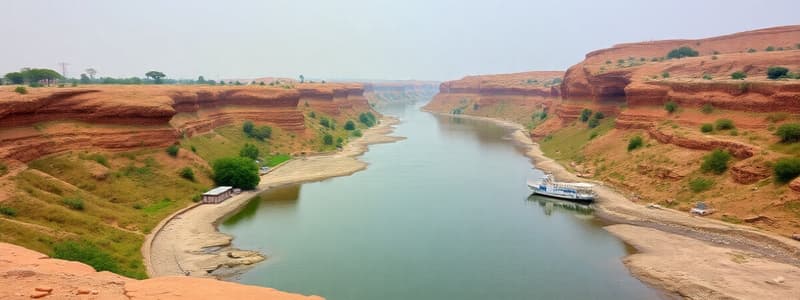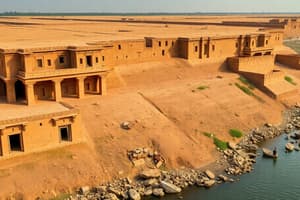Podcast
Questions and Answers
Which factor most significantly contributed to India's diverse culture throughout its history?
Which factor most significantly contributed to India's diverse culture throughout its history?
- Geographic isolation that prevented foreign influence and preserved unique traditions.
- A completely homogenous population with shared customs and languages from the beginning of its civilization.
- Consistent rule under strong, centralized empires that enforced cultural uniformity.
- Frequent migrations and invasions through mountain passes along India's northwestern border. (correct)
The Vedas are not archaeological findings that provide insights into the Indus civilization.
The Vedas are not archaeological findings that provide insights into the Indus civilization.
True (A)
Explain the role of the caste system in maintaining the stability of Indian society over long periods of time.
Explain the role of the caste system in maintaining the stability of Indian society over long periods of time.
The caste system created a rigid social hierarchy that limited social mobility and defined individuals' roles and responsibilities, contributing to the preservation of traditional ways of life and social order.
The concept of reincarnation in Hinduism, where a soul passes through many rebirths before uniting with ________ is known as the wheel of life.
The concept of reincarnation in Hinduism, where a soul passes through many rebirths before uniting with ________ is known as the wheel of life.
Match each concept to its corresponding religion:
Match each concept to its corresponding religion:
What was the primary reason for the decline of Buddhism in India, despite Asoka's efforts to promote it?
What was the primary reason for the decline of Buddhism in India, despite Asoka's efforts to promote it?
The Gupta Empire collapsed due to internal rebellions, rather than external invasions.
The Gupta Empire collapsed due to internal rebellions, rather than external invasions.
How did the religious beliefs of Hinduism and Buddhism influence the daily lives and social structures of ancient Indian society?
How did the religious beliefs of Hinduism and Buddhism influence the daily lives and social structures of ancient Indian society?
The Mauryan ruler ________ is known for converting to Buddhism and erecting stupas and pillars with Buddhist teachings.
The Mauryan ruler ________ is known for converting to Buddhism and erecting stupas and pillars with Buddhist teachings.
Match the empire with its lasting contribution:
Match the empire with its lasting contribution:
Which of the following statements best describes the relationship between Hindus and Muslims in India following the Muslim conquests?
Which of the following statements best describes the relationship between Hindus and Muslims in India following the Muslim conquests?
The earliest Indian civilization began along the riverbanks of the Nile River.
The earliest Indian civilization began along the riverbanks of the Nile River.
Explain how the physical geography of India influenced its early civilization and cultural development.
Explain how the physical geography of India influenced its early civilization and cultural development.
Siddhartha Gautama, also known as the ________, founded Buddhism after seeking enlightenment.
Siddhartha Gautama, also known as the ________, founded Buddhism after seeking enlightenment.
Match the key historical figure with their primary contribution to Indian history:
Match the key historical figure with their primary contribution to Indian history:
Flashcards
India
India
A triangular subcontinent extending from southern Asia into the Indian Ocean, characterized by diverse topography, climate, and population.
Topography
Topography
The physical features of a land, such as mountains, rivers, and plains.
Indus River
Indus River
The river from which India derives its name; the site of the earliest Indian civilization.
Indus Civilization
Indus Civilization
Signup and view all the flashcards
Mohenjo-Daro and Harappa
Mohenjo-Daro and Harappa
Signup and view all the flashcards
Aryans
Aryans
Signup and view all the flashcards
Vedas
Vedas
Signup and view all the flashcards
Joint Family
Joint Family
Signup and view all the flashcards
Caste
Caste
Signup and view all the flashcards
Brahmans
Brahmans
Signup and view all the flashcards
Sudras
Sudras
Signup and view all the flashcards
Outcastes (Untouchables)
Outcastes (Untouchables)
Signup and view all the flashcards
Brahman
Brahman
Signup and view all the flashcards
Reincarnation (Wheel of Life)
Reincarnation (Wheel of Life)
Signup and view all the flashcards
Nirvana
Nirvana
Signup and view all the flashcards
Study Notes
Overview
- The historical books of the Bible focus on Israel, Egypt, Babylon, Persia, Greece, and Rome
- Empires such as India, China, and Africa also developed
- Christianity is growing quickly in Asia and Africa
- Understanding the cultures of these areas aids Christians
India
- India is diverse in topography, climate, and population
- The triangular subcontinent stretches from southern Asia into the Indian Ocean as a peninsula
- Terrain ranges from rainforests to deserts, from coastal plains to the Himalayas
- The earliest Indian civilizations began alongside the Indus and Ganges Rivers
- Natural barriers such as mountains and seas did not isolate India
- Merchants, invaders, and tribes crossed the northwestern border, resulting in a mix of peoples, customs, and languages
Early Civilization
- India gets its name from the Indus River, where the earliest civilization flourished around 2300 BC
- Knowledge of this civilization comes from the cities of Mohenjo-Daro and Harappa
- These cities were carefully planned with straight streets and brick houses
- Evidence shows they had advanced drainage and sewer systems
- Early inhabitants traded with Egypt and Mesopotamia
- Around 1500 BC the Aryans migrated into the Indus Valley
- The Aryans were herdsmen that established the Sanskrit language
- Knowledge of the Aryans comes from the Vedas, religious literature containing traditions and beliefs
- The formative of Indian history lasted from 1500 to 500 BC
Key Features of Indian Society
- Indian society has changed little since ancient times
- The family is important with the extended or joint family, with the oldest male as the authority
- Individual interests were secondary to the family
- Parents chose spouses to maintain family position
- The Aryans settled in rural villages governed by a headman or council of elders
- Village life has remained vital
- Indian population was divided into rigid social groups called castes, with strict rules for each
- Marriage outside one's caste was forbidden
- There were thousands of castes divided into four class groups: priests (Brahmans), rulers/warriors, merchants/traders, and servants/serfs (Sudras)
- Outcastes ("untouchables") were outside the caste system performing menial tasks
- The status of the caste could not be changed
- The caste system explains the lack of change Indian society
Mohenjo-Daro
- The city was built around 2300 BC, carefully planned with wide streets
- Houses had thick walls to keep cool, built with kiln-baked bricks
- Each house had a well, with drains taking dirty water out of the city
- The city had public baths and a granary
- The city was violently destroyed, possibly by Aryan invaders
- The city was never rebuilt, but recent excavations show there was a grim ending
Religion and the Indian Way of Life
- Religion has shaped Indian culture
- Hinduism and Buddhism originated in India and impacted Asian culture
Hinduism
- Hinduism is ingrained in the Indian way of life and has preserved traditions
- It has no formal doctrine, absorbing gods and concepts
- Over 80% of India are Hindus
- Religious literature like the Vedas and Upanishads contain its tenets
- Hindus believe in Brahman, a great god, that permeates everything
- All deities are manifestations of Brahman, which is referred to as the world soul
- Reincarnation is the process of reuniting the soul with the world soul
- The cycle of rebirths is called the wheel of life
- A person's deeds determine their status in the next life
- Good deeds lead to a higher caste in the next life
- Evil deeds may result in rebirth into a lower caste or animal life
- By following rituals and duties of caste Hindus believe they can gain release and unite with the world soul
Buddhism
- Founded by Siddhartha Gautama (563-483 BC), later called Buddha, the "Enlightened One"
- Gautama sought deliverance from suffering and renounced his life
- He attained enlightenment through meditation
- Buddha's Four Noble Truths:
- Suffering is part of existence
- Suffering is caused by selfish desires
- Suffering can be overcome by destroying selfish desires
- Following the Eightfold Path destroys selfish desires
- The Eightfold Path includes correct beliefs, intentions, speech, conduct, livelihood, effort, thoughts, and meditations
- Buddhists believe people don't need gods to obtain freedom from suffering
- Nirvana is the state of peace where one loses himself into nothingness
- Hindus and Buddhists believe man can achieve eternal peace by living a good life
- The Bible teaches that union with god is through Jesus Christ
Lack of Political Unity
- Indian society has remained the same but political history has changed
- India has been a patchwork of small rival kingdoms
- Foreign invaders established empires provided unity and stability
Mauryan Empire
- In 326 BC Alexander the Great threatened India
- Alexander's army conquered small kingdoms in India's northwestern region but turned back
- Chandragupta Maurya created the Mauryan Empire
- Asoka, Chandragupta's grandson, extended the empire
- He renounced war, converted to Buddhism, and promoted the religion
- Asoka built Buddhist shrines (stupas) and inscribed teachings on stone pillars
- He sent Buddhist missionaries abroad
- Buddhism spread across Southeast Asia but didn't gain a wide following in India
- Hindu priests viewed Buddhism as dangerous to the caste system
Gupta Empire
- The Mauryan Empire collapsed after Asoka's death (232 BC)
- India enjoyed profitable trade with Rome and China during a time of turmoil
- The Gupta Empire reunited northern India in the fourth century AD
- India entered a new era of prosperity and achievement
- Trade flourished, culture spread, and universities attracted students
- There were advances in textiles and ironwork
- It was one of the finest periods of Indian art, architecture, literature, and science
- Gupta literature was renowned for fables and fairy tales
- Kalidasa was an Indian poet and dramatist
- Advances in mathematics, science, and medicine occurred
- Arabic numerals came from India
- Indian mathematicians used negative numbers, the decimal, and zero
- Indian scientists developed theories of gravity
- Indian astronomers knew the earth was round and rotated
- Indian physicians performed surgical procedures in free hospitals
- In the sixth century, the Gupta Empire collapsed under attacks of the White Huns
- India became divided into small warring kingdoms
- Hinduism absorbed foreign cultures
Muslim Domination
- Muslim warriors established a kingdom near Delhi in 1206
- Conflict arose between Muslims and Hindus
- Hindus believed in many gods, while Muslims acknowledged one
- Hindus followed the caste system, while Muslims believed in equality
- Muslim control ended at the close of the fourteenth century, leaving hostilities between Hindus and Muslims
Spread of Gospel To India
- According to tradition, the apostle Thomas brought the gospel to India
- Travel between the Roman Empire and India was common in the first century
- Christians likely brought the gospel to India
- Pantaenus traveled as a missionary to India and found Christians with copies of the Gospel of Matthew
- By the fourth century, Christians in Persia contacted Christians in India
- Indians sent leaders to schools in Persia for training until Muslims conquered Persia
- The communities of Indian Christians were still in existence when the Portuguese landed in India in the fifteenth century
Studying That Suits You
Use AI to generate personalized quizzes and flashcards to suit your learning preferences.




